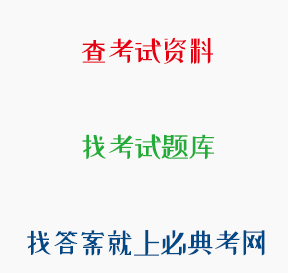正确答案: B
Vagueness.
题目:请阅读 Passage 1,完成1~5小题。 Passage 1 In the field of psychology,there has long been a certain <u>haziness</u> surrounding the definition of creativity,an I-know-it-when-I-see-it attitude that has eluded a precise formulation.During our conversation,Mark Beeman,a cognitive neuroscientist at Northwestern University,told me that he used to be reluctant to tell people what his area of study was,for fear of being dismissed or misunderstood.What,for instance,crosses your mind when you think of creativity? Well,we know that someone is creative if he produces new things or has new ideas.And yet,as John Kounios,a psychologist at Drexel University who collaborates frequently with Beeman,points out,that view is wrong,or at least not entirely right."Creativity is the process,not the product," he says. To illustrate,Beeman offers an example.Imagine someone who has never used or seen a paperclip and is struggling to keep a bunch ofpapers together.Then the person comes up with a new way of bending a stiff wire to hold the papers in place. "<u>That</u> was very creative," Beeman says.On the flip side,if someone works in a new field-Beeman gives the example of nanotechnology-anything that he produces may be considered inherently "creative".But was the act of producing it actually creative? As Beeman put it,"Not all artists are creative.And some accountants are very creative." Insight,however,has proved less difficult to define and to study.Because it arrives at a specific moment in time,you can isolate it,examine it,and analyze its characteristics."Insight is only one part of creativity," Beeman says."But we can measure it.We have a temporal marker that something just happened in the brain.I'd never say that's all of creativity,but it's a central, identifiable component." When scientists examine insight in the lab.they are looking at what types of attention and thought processes lead to that moment of synthesis: If you are trying to facilitate a breakthrough,are there methods you can use that help? If you feel stuck on a problem,are there tricks to get you through? In a recent study,Beeman and Kounios followed people's gazes as they attempted to solve what's called the remote-associates test,in which the subject is given a series of words,like "pine" "crab" and "sauce" and has to think of a single word that can logically be paired with all of them.They wanted to see if the direction of a person's eyes and her rate ofblinking could shed light on her approach and on her likelihood of success.It turned out that if the subject looked directly at a word and focused on it-that is,blinked less frequently,signaling a higher degree of close attention-she was more likely to be thinking in an analytical,convergent fashion,going through possibilities that made sense and systematically discarding those that didn't.If she looked at "pine" say,she might.be thinking of words like "tree" "cone" and "needle" ,then testing each option to see if it fit with the other words.When the subject stopped looking at any specific worD.either by moving her eyes or by blinking,she was more likely to think of broader,more abstract associations.That is a more insight-oriented approach."You need to learn not just to stare but to look outside your focus," Beeman says.(The solution to this remote-associates test: "apple" .) As it turns out,by simple following someone's eyes and measuring her blinks and fixation times,Beeman's group can predict how someone will likely solve a problem and when she is nearing that solution.That's an important consideration for would-be creative minds: it helps us understand how distinct patterns of attention may contribute to certain kinds ofinsights.
解析:词汇题。根据第一段中的“In the field of psychology,there has long been a certain haziness surrounding the definition of creativity,an I-know-it-when-I-see-it attitude that has eluded a precise formulation.”可知,在心理学领域,“创造性”一直没有形成准确的定义。大家所持的态度就是“当我看到创造力的时候,我就知道什么是创造力”,以这种态度避开了对创造力定义的精确化。既然是避开了精确化,那
学习资料的答案和解析:
不均衡性
社会的政治经济制度
坚持社会主义方向
爱岗敬业
Jigsaw listening.
不平衡性
准备律
- When a teacher asks students to discuss how the writer's ide
- 依据《中华人民共和国未成年人保护法》,依法设置的专门学校(
- 如果学生要学习的知识内容比较复杂、结构化程度很高,又必须在较
- 指出下列推理中正确的一项是:( )
- 以下不属于教师的义务的是( )。
- 教师资格证-高中英语2022冲刺密卷答案解析(06.13)
- 学生干部选举前,有的家长给班主任陈老师送来礼物请求照顾,陈老
- 课堂提问需要遵循哪些原则?课堂提问能提高学生哪方面的能力?
- 教师让四名学生每人去拿一只桌球,不论什么颜色。学生拿了球后,
- 材料: 创新是一个人人熟知的名字,但创新到底意味着什么?

 川公网安备 51012202001360号
川公网安备 51012202001360号